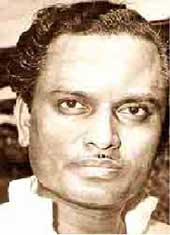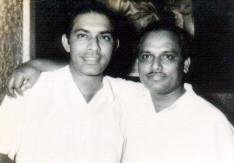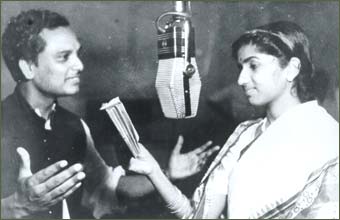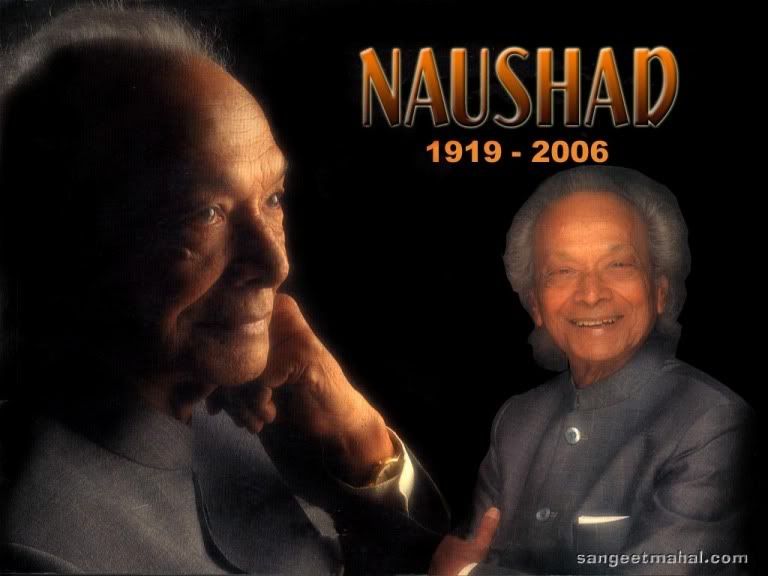
Anil Krishna Biswas or simply "Anil-da" to his friends, was born on July 7, 1914. He was born in Barisal (now Bangladesh). His father was Jagadish Chandra Biswas, who was a lower level government employee. His mother was musically inclined and frequently used to sing bhajans. She arranged for Anil to have basic music training at a very young age.
He showed much interest in music and the theatre as a child. He excelled in the art of tabla and in singing. He was a frequent participant in amateur theatre productions. He was accomplished in the performance of kheyal, thumri and dadra, as well as devotional music.
However these were turbulent times and politics imposed itself on everyone. As a student he immersed himself into the freedom struggle. He was involved in a series of bombings and on six occasions was sent to jail. This was while he was still doing his matriculation (roughly equivilent of High School). Ultimately his involvement in revolutionary activities proved to be such a disruption that his education could not be continued. When his father died in 1930, the young Anil was forced to leave for Calcutta in disguise to evade arrest.
Life in Calcutta was very difficult for the young Anil Biswas. He initially worked in a series of small jobs but then got a small position as a private music teacher. But this was interruped when his past caught up with him. The police came and arrested him and he was again sent to jail.
Not long after his release from Prison, Kazi Nazrul Islam, used some influence to get Anil Biswas a job. This was with the Megaphone Gramophone Company. He performed for numerous recordings but for various reasons, the recordings were not released. Since this was not working out, Anil-da found it necessary to go elsewhere.
He joined the Rangamahal theatre group. This job was obtained through the assistance of Nityayi Motilal who was an accomplished music director of the time. Anil Biswas worked in the company as an actor, singer, and assistant music director. He began composing music for plays and proved to be an accomplished singer. He was with this group for two to three years from 1932 to 1934. During this period, his reputation was improving.
In 1934 he left Calcutta, and moved to Bombay. The film director Hiren Bose knew him from their days in Calcutta, and told Anil that if he wanted to work in the film industry, he needed to move to Bombay. Hiren Bose managed to secure a position for Anil at the Kumar Movietone. But this did not last very long. After some time, he got into a fight with management and was quickly out of a job.
He was not out of a job very long, for he soon got as position in the Eastern Art Syndicate. He worked in various capacities, but was able to debut as a music director with "Dharam ki Devi" (1935). From 1934 until 1936, he was involved in 11 films.

A younger Anil Biswas
In 1936 he moved to Sagar Movietone. During this period he worked in several capacities. Sometimes he was a composer, an assistant music director, a singer and occasionally music director. During this period he worked on a number of films. However it was the popularity of the Mehboob Khan film "Jagirdar" (1937), which proved that he could turn out hit songs. He stayed with Sagar Movietone until 1939.
In 1939 Sagar Movietones was merged with RCA's newly formed National Studio. He returned in 1940. He continued with them until 1942. During this period he worked on a number of projects, including three Mehboob Khan films, "Aurat" (1940), "Bahen" (1941) and "Roti" (1942).
From 1942 to 1947 he worked for Bombay Talkies. During his tenure there, he worked on numerous films. It was during this period that he reached the height of his career with the success of "Kismet" (1943). This film broke all records and ran in the theatres longer than any film in history. (This record remained intact until roughly 1978 when "Sholay" surpassed it.) Kismet was not his only success; other hits as well such as "Jwar Bhatta" (1944) and "Milan" (1946).
During this early period, Anil Biswas is said to have influenced a number of singers of the day. He had the biggest influence of Mukesh, Talat Mahmood, and Lata Mangeshkar.

Talat Mahmood with Anil Biswas
It was Anil Biswass who first gave a break to Mukesh. This was in "Pehli Nazar" (1945). During this time it was Anil Biswas who persuaded Mukesh to stop imitating K.L. Saigal and to develop his own style.
Anil Biswas also gave Talat Mahmood his first break. He employed him for "Arzoo" (1949). Talat had a characteristic quiver in his voice that many music directors found annoying, however it was Anil Biswas that persuaded him to keep this, and develop this into his own personal trademark. Further influence was seen in the fact that when Talat first met Anil, Talat was wishing to become an actor. Anil-da pursuaded him that his future was not in acting but in singing.
Anil Biswas is also said to have influenced the style of Lata Mangeshkar. Anil was always very particular about when a singer should or should not break a phrase for a breath. It is also said that it was Anil who coached Lata and helped her improve her breath control.

Anil Biswas with Lata Mangeshkar
His personal life was developing in this period as well. He married Asha Lata, an actress who was working with Sagar Movietones. Theirs was a comfortable domestic situation. They had a comfortable home in "Hindu Colony". His wife attended to mundane household matters, while Anil composes music. Together they had three sons and a daughter. Unfortunately the marriage did not last; they separate in 1954 and divorced.
The 1940's and 1950's saw the Hindi film industry in transition. The studio system was collapsing, and it was being replaced by a much looser distributor oriented system. In this system there was a much greater reliance on the independent producer.
Anil Biswas responded to this changing business environment by going freelance. He left Bombay Talkies in 1947 and started to work independently. During the 1950's, he served as the music director for a number of films. Some notable films of his were "Abhimaan" (1957) and "Pardesi" (1957).
This period's saw developments in his personal life as well. 1n 1947 he was working on a film "Anokha Pyar". In this movie there were songs by Meena Kapoor. She had previosly been doing work for SD Burman. Anil and Meena developed an amorous relationship. After the divorce from his first wife he married Meena. This marriage was stable and lasted until Anil's death.
1961 was a pivotal year for him. During this period his younger brother died. His elder son Pradeep died in a car accident. Furthermore popular tastes in music were changing and leaving him behind. This coupled with a general disillusionment with the whole Bombay film industry just reached a point where he could no longer continue. He left Bombay and shifted his residence to Delhi.
Life in Delhi was a different. He did work on two more films; these were "Sautela Bhai" (1962), and his last film "Chhoti Chhoti Baatein" (1965). Unfortunately both of these films did poorly in the box office.
Much of the time that he was in Delhi, he was associated with All India Radio, and to a lesser extent Doordarshan . From 1963to 1965 he was the director of AIR's National Orchestra. In 1965 he became the Chief Producer of Sugam Sangeet. With a two year break when he was the Vice Chancellor of Jawaharlal Nehru University, he served with AIR (Delhi) from 1963 to 1975. He did the music for Door Darshan's "Hum Log" (1984), "Baisakhi" and "Phir Wohi Talaash".
He has also worked on numerous documentaries with the Films Division. He won the "Sangeet Natak Akademi Award" in 1986.
He died in Delhi on May 31, 2003.
Here are some of his composition
https://www.youtube.com/watch?v=FHWdievNEmU
https://www.youtube.com/watch?v=A3iHCdLUlkw
https://www.youtube.com/watch?v=funBs-fw9GE
https://www.youtube.com/watch?v=n0GZSrK9b8c
https://www.youtube.com/watch?v=Yu0ibF46cio
https://www.youtube.com/watch?v=RWdldFptbmA





